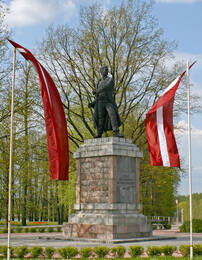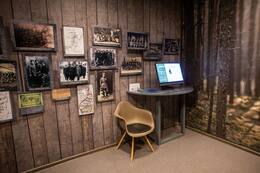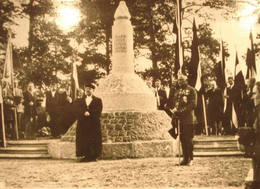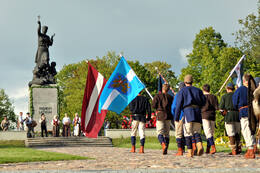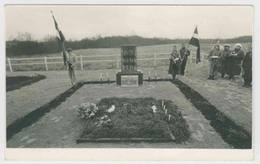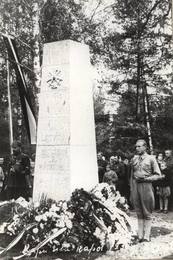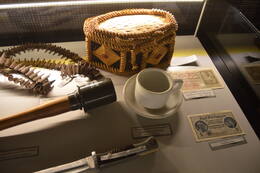Partisan activity in Northern Latgale
I Wars of Independence
The first Latgale partisan attacks on the Soviet Latvian army began in March 1919. In May, several large military units of about 30 men were established in Kuprava, Rugāja and elsewhere. On May 29 and 30, partisan units attacked parts of the Soviet Latvian army coming from North Vidzeme through Balvi. On June 15, the Bolshevik armed train managed to occupy Kuprava station, on June 21 they tried to make a repeated attack in the direction of Balvi station. The partisans, together with about 100 Estonian soldiers, surrounded the train and forced it to retreat in the direction of Pitalova. In the summer of 1919, partisans captured Liepna and Balvi with the support of Estonian soldiers. On July 5, 1919, the representatives of the partisan groups decided to unite in one regiment at the meeting in Balvi; Initially, the partisan regiment had four ornaments. From July 13, the regiment came under the command of the commander of the Kurzeme division. 28.-30. In July, fights took place near Baltinava and at Punduri station, Vilaka was captured. After the battles at Stompakai and Susāja, the 5th Company of the Regiment was formed from the local partisans. On August 9, the 6th Company was formed from the Liepna Partisan Division, which occupied Liepna on September 22. In October 1919, the partisan regiment grew to 2,000 men, so it was reorganized and formed three battalions with 8 ornaments, and the 9th company formed a fourth battalion. On October 4, Lieutenant Colonel Jānis Skujiņš (1897-1942) was appointed commander of the regiment. On October 16, the 2nd Battalion of the regiment occupied Nostrov and Stompakus. 7.-9. In November, the Red Army counterattacked and regained the positions lost in October. In January 1920, the regiment had 49 officers and 2,400 fighters, who also had machine guns. The regiment took part in the liberation operations of Northern Latgale in January and February 1920. During the War of Independence, the Latgale partisan regiment lost 145 dead. 40 soldiers of the regiment were awarded the Lāčplēsis War Order. On August 14, 1938, at the intersection of Brīvības and Partizānu streets in Balvi, a monument to the fallen soldiers of the Latgale partisan regiment "Guarding partisan" was unveiled.
More information sources
Jānis Skujiņš. Latgale partisan regiment. Book: To commemorate the 15th anniversary of the liberation of Latgale. 1920-1935 Rezekne, 1935, pp. 32-33; also: http://www.periodika.lv/periodika2-viewer/view/index-dev.html#panel:pp|issue:/g_001_0307061306|article:DIVL259|page:32|issueType:undefined
Latgale partisan regiment. Wikipedia. https://en.wikipedia.org/wiki/Latgales_partiz%C4%81nu_pulks
Related timeline
Related objects
Monument to the fallen soldiers of the Latgale Partisan Regiment 1919 - 1920
During the Latvian War of Independence (1918-1920), the Balvi Partisan Division was formed in the Balvi region on the initiative of local residents, which was soon transformed into the Latgale Partisan Regiment.
The idea for a regimental monument arose as early as 1927. In 1933, former Latgale Partisan Regiment soldier and stonemason Jānis Pilmanis built a 5-meter-high stone pedestal for the monument at his own expense. The bronze monument itself was created by artist Kārlis Jansons.
The monument dedicated to the memory of the fallen soldiers of the regiment was unveiled on August 14, 1938, with the participation of General Jānis Balodis. Although the official name of the monument was “Guarding Partisan”, the people soon simply called the monument “Balva Stanislava”.
After Latvia was occupied by the USSR, the monument was demolished in the spring of 1941 by decision of the Abrene County Executive Committee. The high pedestal was demolished, but the bronze monument itself remained in the Balvi police yard.
During the German occupation, the monument's pedestal was not restored, but the bronze monument itself was placed in its previous location. After the second return of the Soviet occupiers in 1944, the monument was completely destroyed.
When Latvia regained its independence, the people of Balvi collected donations for the restoration of the Latgale Partisan Monument. On November 11, 1993, the restored monument by Andrejs Jansons, son of artist Kārlis Jansons, was unveiled in Balvi.
An additional commemorative plaque was added to the back of the monument's pedestal with the text "Renovated also honoring the Latgale national freedom fighters of 1940-1954."
Exhibition "North Latgale in the Freedom Struggle" at the Balvi Regional Museum
The museum is located in the territory of the Balvi Manor complex, in the building of the former manor barn. The exhibition allows you to look into the history of the Latvian War of Independence from the point of view of Northern Latgale, tracing the history of the formation and activities of the Latgale Partisan Regiment. There are photographs and copies of documents that are not available elsewhere, including the order of 5 July 1919 on the formation of the regiment. The internal orders of the regiment are unique – they were written in Russian between July and October 1919. This reflects the peculiarities of the formation and composition of the regiment as a local unit, where Latvians, Latgalians, Russians, and Jews fought together. The regiment only switched to Latvian in its internal orders after it was fully integrated into the Latvian Army system when it was supplemented by mobilised soldiers from other regions of Latvia. The exhibition also reflects the liberation operation of Northern Latgale, during which the Latgale Division of the Latvian Army liberated the surroundings of Viļaka, Jaunlatgale and Kārsava in battles that lasted from 9 to 15 January 1920. Evidence of both the operation as a whole and the combat activities of the Latgale Partisan Regiment during the liberation of Kārsava are on display in the exhibition.
Monument to the soldiers who fell in the Latvian liberation struggle in Yaškovo
Located on the left side of the Viļaka – Vientuļi road section (P35), near the Jaškova cemetery chapel.
Monument to the Latvian and Estonian soldiers who fell in the War of Independence.
The monument, created by sculptor Kārlis Zemdega in memory of the soldiers who fell in the 1920 Liberation War in Jaškovo, was first unveiled on September 22, 1935, at the Viļaka Brothers Cemetery, established in 1929.
The freedom struggle against the Red Army in the Viļaka region began with the attack of the Latvian Army and the Latgale Partisan Regiment on January 9, 1920. Estonian soldiers also participated in it. Viļaka was liberated on January 9, but the fighting to the east of it continued for several more days. Both before and after the liberation of Viļaka, the fallen soldiers were buried in various places known to the local population. As the Latvian state stabilized, people began to think about arranging a common fraternal cemetery in Viļaka. Already on November 18, 1923, after a solemn service in the Catholic church, held by Dean P. Apšinīks, a large procession went to the newly created fraternal cemetery on a hill, in the so-called Jaškovs - in the immediate vicinity of Viļaka. Soon the foundations of the monument were built, and donations for the monument began to be collected. The identification of the graves of the fallen soldiers took time, and only on November 3, 1929, the reburial in the future fraternal cemetery took place. 31 Latvian and 14 Estonian soldiers who fell in the Viļaka area were buried there. In 1935, the monument was ready and it was solemnly consecrated on September 22.
During the pre-war years of Latvian independence, all important national events in Viļaka parish were associated with the fraternal graves and this monument.
The monument was destroyed during the post-war years of Soviet rule, but its granite parts, although damaged, were preserved. The monument was restored on November 11, 1990 - Lāčplēsis Day.
Monument “Vienoti Latvijai” (“United for Latvia”) or Māra of Latgale
The Monument “Vienoti Latvijai” (“United for Latvia”) or Māra of Latgale is located in Rēzekne. Its central image of a woman holding a cross in her hand symbolises the Latgale region of Latvia, which was liberated from Bolshevik rule in 1920, and its spirit of Christian civilisation.
The monument was initiated by public figures of Latgale in the 1920s. The foundation stone was laid and consecrated on 8 June 1930. In June 1934, a competition for the design of the monument was announced, and the design by Kārlis Jansons won the com petition. The monument was unveiled on 8 September 1939, and the consecration service was held by Bishop Jāzeps Rancāns.
After the Soviet occupation in November 1940, the monument was pulled down. The bronze sculptures were not destroyed due to a shortage of time and the monument was restored on 22 August 1943, during the German occupation. When the Soviet occupation returned, the cross was initially sawn off, while, in 1950, the monument was completely destroyed.
During the Soviet occupation, a Lenin monument was erected instead, which was removed immediately after Latvia regained its independence in 1991.
During the Awakening in 1989, the idea of restoring the historical United for Latvia monument was born. The monument was recreated by the sculptor Andrejs Jansons, the son of Kārlis Jansons, in collaboration with Inta Folkmane, based on his father’s materials and photographs. The restored monument was unveiled on 13 August 1992, during the First World Gathering of Latgalians.
Memorial stone to the green partisans
Located in Ērgļi on the corner of Parka and Saules streets near the railway viaduct.
On May 23, 1919, the Green Partisans attacked a column of Bolshevik carters in the center of Ērgļi. The battle lasted two hours, and the Partisans captured 78 horses and many carts with rifles and other goods. Four Partisans died in the battle, and one was wounded. In total, 61 men fought in the ranks of the Partisans in the region, of whom six died.
On May 21, 1939, a memorial stone was erected in the village of Ērgļi by the 121st Ērgļi Small Regiment at the site where the Green partisans Jānis Andriksons, Andrejs Bumbers, Kārlis Baņģieris and Jānis Gūts fell on May 23, 1919.
During the Soviet occupation, the memorial at the intersection of Parka and Saules streets was demolished. It was restored and reinstalled on April 22, 1989.
Vilaka Museum
Viļaka Museum operates in two buildings – the Catholic parish house, built in 1913, which is an important cultural heritage object of the town, and the other building of the museum – a former monastery of Capuchin monks, whose cellars are closely related to the national partisan movement in Stompaki and the Soviet Cheka. According to the memories of the locals, people were held and tortured in these cellars. The old museum building houses several exhibitions, with one of the exhibitions dedicated to the 1920 freedom battles in Northern Latgale, and the second – to the events of the Second World War – the Jewish Holocaust in Viļaka and information about the families who were shot. More information about each family is available based on their street address.
The exhibition is supplemented by information about the national partisan movement in Stompaki – various testimonies, photographs and objects. Visitors can learn about the military heritage sites in and around Viļaka, such as the Freedom Fighters Monument in Jaškova, which was demolished during the Soviet era and restored in 1990, and the stele dedicated to the recipients of the Order of Lāčplēsis. The sound of World War II aircraft is incorporated into the exhibition of the museum, as the German Luftwaffe airfield was located near Viļaka. The museum offers an opportunity to see some memories of the Second World War events in Viļaka, as well as to receive information about the German prisoner-of-war camp in Rači.
Related stories
Liberation of Northern Latgale from the Bolsheviks
On December 1, 1918, the Red Army units, based on the Red Riflemen units, invaded the territory of Latvia. In order to protect their homes, families, native region and escape from terror, the men of the Balvi area took up arms and went into the forests, the formation of the first “green” groups began. In the spring of 1919, when mobilization was announced, many men of the Balvi area found fighting in the Soviet Latvian Army unacceptable and joined the “green” groups. The Balvi, Silakrogs, Rugāji, Teteru-Dūrupe and Liepna groups were formed. The activities of the “green” groups in the Balvi area became more active in March 1919.





